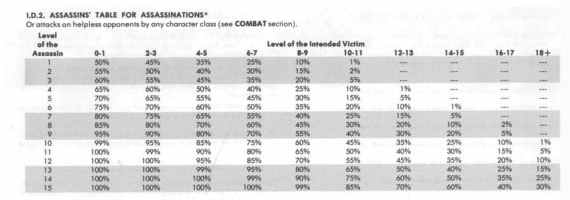Single mechanic RPGs are bad, mkay?
Every time you think your interest in AD&D has run its course, that you’ve done all there is to do, you find another fun little subsystem that forces you to go back to the books and explore a whole new aspect of the game. For me, lately, it’s been the assassination game.
These assassination rules look like a hot mess at first, but the more you dig – and the more you talk to people who are genuinely interested in how they actually play – the more you realize how brilliant and intricate they are.
As a brief aside, I should mention that my first attempt to run a spy ring using these rules ended in tragedy. In an attempt to learn more and do better next time, I took a swing around the internet and found…not much. Too much analysis is spent from the conventional “table only” perspective and not enough from the “what do you think would happen” perspective. Oddly enough, the focus on the rules among the OSR analysts loses sight of the huge gaps in AD&D that allow for individual applications of the rules to a vast sweep of events best covered by rulings.
You really think you can distill all the Surprise Murder plans down to a single table? Think about the disparate plans put into effect by men such as Sirhan Sirhan, Jack Ruby, and Lon Horiuchi, to say nothing of the poisoners and faceless men hired by you know who to kill Seth Rich. That’s a lot of ground to cover in a single sub-system, and Gary found a way to do it that goes far beyond what you can reasonably cover in a normal D&D session without boring half the table. Nobody ever talks about this.
This is not necessarily a shot at previous pundits – my results may be due large part to the general breakdown of search engine functionality – who operated in those dark pre-BROSR days. What you do find today mostly distills the wonderful Murder for Hire sub-game down to a surprise check and a roll on the assassination success table.
You can do that, but you are leaving huge chunks of game and adventure off the table. Gary left us a few paragraphs of guidance, a couple of tables and charts, and a handful of conditional modifiers. With that, he covers a vast sweep of possibilities from sudden ambushes to subtle poisons and everything in between. To get the full effect you have to stop thinking of D&D as that thing that happens around one table with the same or a rotating cast of characters, and start thinking of it as a hobby.
That might sound weird, but what I’m getting at here is that you don’t have to compartmentalize the game so much. You can take it with you and play it “on the go”. You don’t need everyone present at the table. You can text or DM your DM with your intentions and leave everything as vague or as specific as needed to establish the likely results of each decision point and let the game simmer in the backgroud of your life while you wait for the next decision point. The suspense will kill you in all the best ways.
Getting back to assassinations, instead of a couple isolated rolls you should pair the murder attempt with its close cousins, the spying rules and the disguise rules, and you can set up a mini-adventure in your off hours. Do you chuck your target off a balcony and plant a forged note to fake a suicide? Have a hired goon fake a robbery and leave him bleeding out in the streets? Sacrifice a pawn who pulls a knife after being refused an autograph on the target’s front porch? Just have your fanatics go full kamikaze in front of a crowd? The possibilities are as limitless as the human imagination, and history has used variations on all of them.
A simple plan, a little back and forth, and you have everything you need to cover a fun little mini-game that can be easily plugged into your campaign downtime. (Or played at the table in excruciating detail if you prefer and the rest of the players are amenable.)
Take it one at a time, read through and utilize Gary’s rules and advice, and every assassination becomes its own little exercise with its own suite of dice rolls and check points and decision trees. Its own little adventure.
So much more satisfying than just another d20 vs target number roll.



